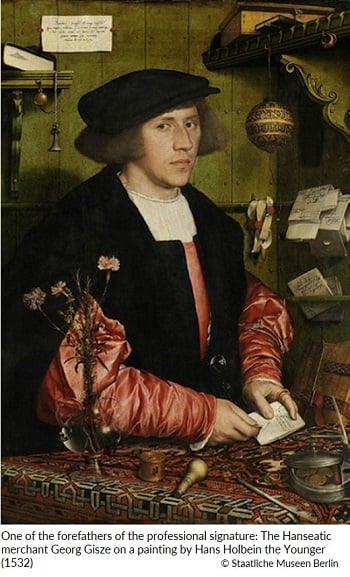Series: Cultural History of the Signature – Part 1

by Christoph Schomberg
in Society & Culture
07 Feb 2022
The signature – its history, its cultural significance and its importance in the digital age: look forward to a short cultural-historical excursion around the signature in our four-part series.
Preface
Those who come into contact with electronic signatures for the first time usually ask themselves whether the electronic signature is really as valid as the handwritten signature. This question, which is still sometimes asked with some trepidation six years after the eIDAS Regulation has come into force, indicates that the history of the signature is an important chapter in legal history. But it is much more than that: it reflects nothing less than the development of Europe in economic and cultural terms. This is what our series on the cultural history of the signature is about.
In the age of electronic signatures, we have a choice: to continue to sign in analogue form or to use digital technology. For larger companies that digitise their correspondence like many other business sectors, the qualified electronic signature based on a personal certificate is without alternative. What will not change any time soon is the aura of authenticity and identity created by signatures and written characters in general. This is what handwritten signatures have in common with their electronic counterparts. That's why our series reflects the cultural significance that signatures have – regardless of whether they appear in the form of pixels or ink.
Part 1 – History
 The success story of the signature from the 15th century onwards is inextricably linked to the flourishing merchant system in Europe. Merchants increasingly took up the pen to make a signature – in view of the growing number of purchase and trade contracts, a thoroughly time-saving, pragmatic method of legally binding declarations of intent. They put their sign or their written name under contracts with a sharp pen.
The success story of the signature from the 15th century onwards is inextricably linked to the flourishing merchant system in Europe. Merchants increasingly took up the pen to make a signature – in view of the growing number of purchase and trade contracts, a thoroughly time-saving, pragmatic method of legally binding declarations of intent. They put their sign or their written name under contracts with a sharp pen.
The threshold from the Middle Ages to modern times is characterised by rapidly growing world trade. New markets emerged and greater distances could be covered in less and less time. Mobility thus played a key role in the spread of the signature. This is also evident in art. For from the 'golden age' in European painting at the latest, a Europe-wide art market emerged in the 17th century. Since artists were no longer obliged to meet the buyers of their works in person, the signature of works finally became accepted as proof of authenticity and became the standard. Another central key to the spread of the handwritten signature was education: More and more people learned to write and were thus able to sign their names in the first place.
Thus, the history of the signature tells of the economisation of the world, of education and yes, if you will, of the origins of globalisation. The signature spread into all areas of life. Not only artists began to sign their works as a matter of principle, states regulated their relations with each other by signing contracts, employment relationships were written down, trade agreements were sealed. The signature became a global cultural technique and a synonym for authenticity. It thus formed the socio-legal basis of all polities.


